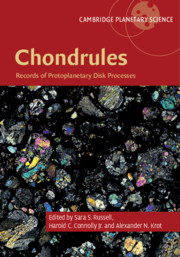Book contents
- Chondrules
- Cambridge Planetary Science
- Chondrules
- Copyright page
- Contents
- Contributors
- 1 Introduction
- Part I Observations of Chondrules
- Part II Possible Chondrule-Forming Mechanisms
- 13 Formation of Chondrules by Planetesimal Collisions
- 14 Making Chondrules by Splashing Molten Planetesimals
- 15 Formation of Chondrules by Shock Waves
- 16 Evaluating Non-Shock, Non-Collisional Models for Chondrule Formation
- 17 Summary of Key Outcomes
- Index
- Plate Section (PDF Only)
- References
15 - Formation of Chondrules by Shock Waves
from Part II - Possible Chondrule-Forming Mechanisms
Published online by Cambridge University Press: 30 June 2018
- Chondrules
- Cambridge Planetary Science
- Chondrules
- Copyright page
- Contents
- Contributors
- 1 Introduction
- Part I Observations of Chondrules
- Part II Possible Chondrule-Forming Mechanisms
- 13 Formation of Chondrules by Planetesimal Collisions
- 14 Making Chondrules by Splashing Molten Planetesimals
- 15 Formation of Chondrules by Shock Waves
- 16 Evaluating Non-Shock, Non-Collisional Models for Chondrule Formation
- 17 Summary of Key Outcomes
- Index
- Plate Section (PDF Only)
- References
Summary
Nebular shock heating is one of the most fully developed and rigorous models for chondrule formation, and is also the most consistent with the meteoritic record. In this review, we compare the results of current shock modeling to the wealth of meteoritic observations, to highlight where there is agreement and where there is potential failure of the models. The discussion is focused on gravitational disk instability-driven, large-scale shocks and on local bow shocks, with attention to the astrophysical setting for both. We suggest that more than one shock driver may be physically motivated and necessary to explain the variety of chondrules.
- Type
- Chapter
- Information
- ChondrulesRecords of Protoplanetary Disk Processes, pp. 375 - 399Publisher: Cambridge University PressPrint publication year: 2018
References
- 11
- Cited by

